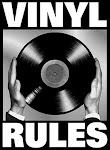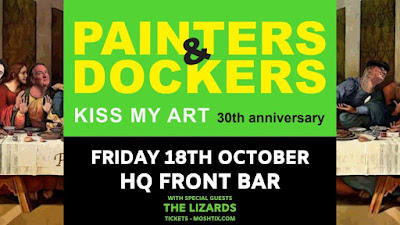Before things get too serious at Rock On Vinyl, I thought it might be fun to post a song at the end of each month, that could be considered to be either Weird, Obscure, Crazy or just plain Korny.....
.
Let’s hear it for Alfred! Mad Magazine released two great albums in the early 1960s: Mad Twists Rock´N´Roll & Fink Along With Mad
A wonderful symbiosis of Mad humour and rock´n´roll. Produced independently by Norm Blagman and Sam Bobrick who then played it for the Mad staff who then saw to it that it was released. Now, let’s do the pretzel!
.
 After the inevitably-titled 45 “What, Me Worry?” MAD moved up to the big leagues with a full-length LP (pressed on vinyl, not cardboard!) 1962’s Mad “Twists” Rock ‘N’ Roll was written and produced by Norm Blagman and Sam Bobrick. The prolific Bobrick later wrote for Andy Griffith, Get Smart, The Paul Lynde Show, The Smothers Brothers, and Saved By The Bell (as well as a very MAD-esque comedy album called Folk Songs Of Madison Avenue, credited to “The Flagpole Singers”); Blagman wrote and arranged for Tiny Tim, contributed to the original 1968 soundtrack of The Producers, co-wrote “Give Me The Right” and “Put The Blame On Me” for Elvis Presley, and would continue making MAD records into the 1980s. The album featured a time capsule of 1962 pop culture preoccupations spoofing James Bond (“Agnes The Teenage Russian Spy”), teenage car-race death ballads (“All I Have Left Is My Johnny’s Hub Cap), and chiropractically-ill-advised dance crazes (“Let’s Do The Pretzel”).
After the inevitably-titled 45 “What, Me Worry?” MAD moved up to the big leagues with a full-length LP (pressed on vinyl, not cardboard!) 1962’s Mad “Twists” Rock ‘N’ Roll was written and produced by Norm Blagman and Sam Bobrick. The prolific Bobrick later wrote for Andy Griffith, Get Smart, The Paul Lynde Show, The Smothers Brothers, and Saved By The Bell (as well as a very MAD-esque comedy album called Folk Songs Of Madison Avenue, credited to “The Flagpole Singers”); Blagman wrote and arranged for Tiny Tim, contributed to the original 1968 soundtrack of The Producers, co-wrote “Give Me The Right” and “Put The Blame On Me” for Elvis Presley, and would continue making MAD records into the 1980s. The album featured a time capsule of 1962 pop culture preoccupations spoofing James Bond (“Agnes The Teenage Russian Spy”), teenage car-race death ballads (“All I Have Left Is My Johnny’s Hub Cap), and chiropractically-ill-advised dance crazes (“Let’s Do The Pretzel”).
.
For most of its history, MAD magazine has been at the forefront of gleefully juvenile printed humour. Its pop culture spoofs are legendary, its cartoonists among the finest humorists of their generation. But along the way, MAD created some of the most fun (and suitably warped) musical creations of the 20th century.
MAD’s first real foray into recorded sound began in the late 50s with Musically Mad. Conceived, composed and directed by Space Age Pop arranger Bernie Green, a veteran of radio comedy who served as musical director of the anarchic, acerbic Henry Morgan Show (and whose later television work included the excellent Garry Moore Show and Wally Cox’s Mr. Peepers.) Morgan himself makes several contributions, helping Green send up everything from Gunsmoke to The Mikado.
 After the inevitably-titled 45 “What, Me Worry?” MAD moved up to the big leagues with a full-length LP (pressed on vinyl, not cardboard!) 1962’s Mad “Twists” Rock ‘N’ Roll was written and produced by Norm Blagman and Sam Bobrick. The prolific Bobrick later wrote for Andy Griffith, Get Smart, The Paul Lynde Show, The Smothers Brothers, and Saved By The Bell (as well as a very MAD-esque comedy album called Folk Songs Of Madison Avenue, credited to “The Flagpole Singers”); Blagman wrote and arranged for Tiny Tim, contributed to the original 1968 soundtrack of The Producers, co-wrote “Give Me The Right” and “Put The Blame On Me” for Elvis Presley, and would continue making MAD records into the 1980s. The album featured a time capsule of 1962 pop culture preoccupations spoofing James Bond (“Agnes The Teenage Russian Spy”), teenage car-race death ballads (“All I Have Left Is My Johnny’s Hub Cap), and chiropractically-ill-advised dance crazes (“Let’s Do The Pretzel”).
After the inevitably-titled 45 “What, Me Worry?” MAD moved up to the big leagues with a full-length LP (pressed on vinyl, not cardboard!) 1962’s Mad “Twists” Rock ‘N’ Roll was written and produced by Norm Blagman and Sam Bobrick. The prolific Bobrick later wrote for Andy Griffith, Get Smart, The Paul Lynde Show, The Smothers Brothers, and Saved By The Bell (as well as a very MAD-esque comedy album called Folk Songs Of Madison Avenue, credited to “The Flagpole Singers”); Blagman wrote and arranged for Tiny Tim, contributed to the original 1968 soundtrack of The Producers, co-wrote “Give Me The Right” and “Put The Blame On Me” for Elvis Presley, and would continue making MAD records into the 1980s. The album featured a time capsule of 1962 pop culture preoccupations spoofing James Bond (“Agnes The Teenage Russian Spy”), teenage car-race death ballads (“All I Have Left Is My Johnny’s Hub Cap), and chiropractically-ill-advised dance crazes (“Let’s Do The Pretzel”).
The success of Mad Twists demanded a follow-up, 1963’s Fink Along With MAD, which featured the same creative team and the same clever spoofs, from the heartfelt “Loving A Siamese Twin” to “She Lets Me Watch Her Mom & Pop Fight”. It also features one of MAD’s most memorable—and most revisited—songs, “It’s A Gas”, which artfully combines percussive belching with a great King Curtis sax solo. Sam Bobrick co-writer of "It's A Gas" annotated in albums credits that the musicians themselves provided the burps. The band loved going up to the mike, we would just have them belch, and then we cut the belches in later. This album is one for the ages. [extract from kittysneezes.com]
Of course, MAD started declining a bit in the 70s, when it was eclipsed by The National Lampoon. It's still going strong, but seems a bit formulaic, and I find it sad that I usually enjoy Cracked (MAD's second-rate competitor for many years) online more than anything I've read in MAD in years.
Society has changed, of course, but both of these MAD albums are still very funny albums in my opinion. But then again, you could call me MAD, MAD, MAD I say, absolutely MAD
This month's MAD post is a prime candidate for the WOCK on Vinyl award, ticking all boxes and more. It's Weird, it's Wacky, it's Obscure in that these recordings were only released on Flexidiscs found inside MAD magazines and above all the songs are Korny yet Catchy. Ripped to MP3 (192kps) - not my rips folks - there is unfortunately little artwork or information associated with these flexi albums. If you are as MAD as a hatter, you will find more MAD material on a previous post found HERE.
.
1. (Throwing the) High School Basketball Game
2. (She Got A) Nose Job
3. Please Betty Jane (Shave Your Legs)
4. Somebody Else´s Dandruff
5. Blind Date
6. Agnes (The Teenage Russian Spy)
7. Let´s Do the Pretzel
8. I´ll Always Remember Being You
9. When My Pimples Turned To Dimples
10. She´s A Serious Teenager In Love
11. (All I Have Left Is) My Johnny´s Hubcap
12. Written On the Boys Bathroom Wall
1. Let´s Do the Fink
2. Her Mustache
3. Biggest Mouth In Town
4. Her Dad´s Got Money
5. His Hair
6. It´s A Gas
7. Don´t Put Onions on Your Hamburger
8. Loving a Siamese Twin
9. She Lets Me Watch Her Mom and Pop Fight
10. The Braces on Your Teeth
11. Contact Lenses
12. The Neighbourhood Draft Board
13. A Mad Extra
.
MAD Flexi Discs MP3 Link (86Mb)
.































































